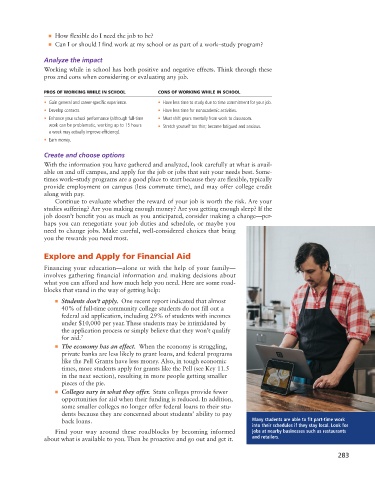Page 321 - Keys To Community College Success
P. 321
■ How flexible do I need the job to be?
■ Can I or should I find work at my school or as part of a work–study program?
Analyze the impact
Working while in school has both positive and negative effects. Think through these
pros and cons when considering or evaluating any job.
PROS OF WORKING WHILE IN SCHOOL CONS OF WORKING WHILE IN SCHOOL
• Gain general and career-specific experience. • Have less time to study due to time commitment for your job.
• Develop contacts. • Have less time for nonacademic activities.
• Enhance your school performance (although full-time • Must shift gears mentally from work to classroom.
work can be problematic, working up to 15 hours • Stretch yourself too thin; become fatigued and anxious.
a week may actually improve efficiency).
• Earn money.
Create and choose options
With the information you have gathered and analyzed, look carefully at what is avail-
able on and off campus, and apply for the job or jobs that suit your needs best. Some-
times work–study programs are a good place to start because they are flexible, typically
provide employment on campus (less commute time), and may offer college credit
along with pay.
Continue to evaluate whether the reward of your job is worth the risk. Are your
studies suffering? Are you making enough money? Are you getting enough sleep? If the
job doesn’t benefit you as much as you anticipated, consider making a change—per-
haps you can renegotiate your job duties and schedule, or maybe you
need to change jobs. Make careful, well-considered choices that bring
you the rewards you need most.
Explore and Apply for Financial Aid
Financing your education—alone or with the help of your family—
involves gathering financial information and making decisions about
what you can afford and how much help you need. Here are some road-
blocks that stand in the way of getting help:
■ Students don’t apply. One recent report indicated that almost
40% of full-time community college students do not fill out a
federal aid application, including 29% of students with incomes
under $10,000 per year. These students may be intimidated by
the application process or simply believe that they won’t qualify
for aid. 7
■ The economy has an effect. When the economy is struggling,
private banks are less likely to grant loans, and federal programs
like the Pell Grants have less money. Also, in tough economic
times, more students apply for grants like the Pell (see Key 11.5
in the next section), resulting in more people getting smaller
pieces of the pie.
■ Colleges vary in what they offer. State colleges provide fewer
opportunities for aid when their funding is reduced. In addition,
some smaller colleges no longer offer federal loans to their stu-
dents because they are concerned about students’ ability to pay
back loans. Many students are able to fit part-time work
into their schedules if they stay local. Look for
Find your way around these roadblocks by becoming informed jobs at nearby businesses such as restaurants
about what is available to you. Then be proactive and go out and get it. and retailers.
283

